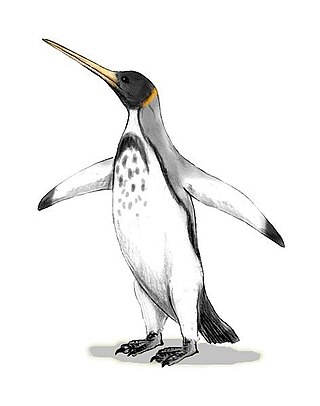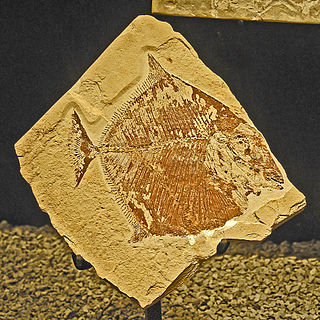Related Research Articles

Sudamerica, literally "South America" in Spanish, is a genus of mammal from the extinct suborder Gondwanatheria that lived in Patagonia, Argentina and Antarctica from the Middle Paleocene (Peligran), just after the end of the "Age of Dinosaurs", to the Early Eocene (Casamayoran).

Carcharhinus is the type genus of the family Carcharhinidae, the requiem sharks. One of 12 genera in its family, it contains over half of the species therein. It contains 35 extant and eight extinct species to date, with likely more species yet to be described.

Ailuravus is a genus of prehistoric rodents in the family Ischyromyidae.
Victorlemoinea is an extinct litoptern genus of the family Sparnotheriodontidae, that lived from the Early to Middle Eocene. Fossils of Victorlemoinea have been found in the Las Flores, Sarmiento and Koluel Kaike Formations of Argentina, the Itaboraí Formation of Brazil and La Meseta Formation, Antarctica.

Icadyptes is an extinct genus of giant penguins from the Late Eocene tropics of South America.

Carcharias is a genus of mackerel sharks belonging to the family Odontaspididae. Once bearing many prehistoric species, all have gone extinct with the exception of the critically endangered sand tiger shark.

Hadrianus is an extinct genus of tortoise belonging to the Testudinidae found in the United States, the Yolomécatl Formation of Mexico, the Alai Beds of Kyrgyzstan and Spain and believed to be the oldest true tortoise known. The genus is thought to be closely related to the genus Manouria. The genus may have evolved in the subtropics of Asia and subsequently migrated to North America and Europe.

Palaeobalistum is an extinct genus of prehistoric ray-finned fish which ranged from the Cretaceous to Eocene periods.
Pseudoglyptodon is a genus of extinct sloths from South America. The type species is Pseudoglyptodon sallaensis.

The Trionychinae are a subfamily of turtles in the family Trionychidae.

Umayodus is an extinct genus of "condylarth" mammal from the late Paleocene or the earliest Eocene. It is a didolodontid which lived in what is now Peru. It is known from the holotype LU3-801, an isolated right third molar, which was found in the Muñani Formation of Laguna Umayo, Peru. It was first named by Javier N. Gelfo and Bernard Sigé in 2011 and the type species is Umayodus raimondi.
Antarctodon is an extinct genus of mammals from the Early Eocene. It is a basal astrapotherian which lived in what is now Seymour Island, Antarctic Peninsula, at that moment still connected to South America where most of the astrapotherians were found. The holotype and only specimen MLP 08-XI-30-1, an isolated right p4 or m1, was found in the Telm 5 Member of the La Meseta Formation in West Antarctica. It was first named by Mariano Bond, Alejandro Kramarz, Ross D. E. MacPhee and Marcelo Reguero in 2011 and the type species is Antarctodon sobrali.

Baenidae is an extinct family of paracryptodiran turtles known from the Early Cretaceous to Eocene of North America. While during the Early Cretaceous they are found across North America, during the Late Cretaceous they are only found in Laramidia, having disappeared from Appalachia. The majority of lineages survived the K-Pg Extinction, but the family was extinct by the latest Eocene. The name of the type genus, Baena, appears to be of Native American origin. They are primarily found in freshwater deposits, and are considered to be aquatic, with a largely generalist habit.
Afrodon is an extinct genus of eutherians in the family Adapisoriculidae. Its type species is Afrodon chleuhi, known from the late Palaeocene of Morocco. The other known species are Afrodon germanicus from the late Palaeocene of Germany and France, Afrodon tagourtensis from the early Eocene of Morocco, Afrodon ivani from the late Palaeocene of Spain, and Afrodon gheerbranti from the early Paleocene of Belgium. Its range spread from the Cernaysian to the Grauvian in the European land mammal ages.

The Elko Formation, also known as Elko Shale(s), is an oil shale geologic formation in Elko County, northern Nevada, United States. The deltaic and lacustrine shales and limestones preserve fossils dating back to the Middle Eocene of the Paleogene to Middle Miocene of the Neogene period. The frog genus Elkobatrachus and ant species Pseudocamponotus elkoanus were named after the formation.
Wyonycteris is a genus of small mammals that existed in the late Paleocene and early Eocene epochs. The type species is Wyonycteris chalix, which lived in Wyoming during the Clarkforkian North American Land Mammal Age of the Paleocene and was originally proposed to be an early form of insectivorous bat. Later re-examination of the material has put this alliance in doubt, and the genus has instead been proposed as belonging to the subfamily Placentidentinae, within the family Nyctitheriidae. Similar fossil material of the same time period found in Europe was later discovered and described as new species, Wyonycteris richardi.
Palaeophasianus is an extinct genus of flightless Geranoididae birds that lived in North America during the Eocene period. Robert Wilson Shufeldt classified Palaeophasianus as a galliform when he described it in 1913. However it was transferred to Cracidae in 1964 by Pierce Brodkorb, while Joel Cracraft in 1968 placed it in Gruiformes.
Simpsonotus is an extinct genus of notoungulate mammals in the family Henricosborniidae from the Middle to Late Paleocene of South America. Fossils of the genus have been found in the Mealla Formation, a fluvial and lacustrine sedimentary unit of the Salta Basin in northwestern Argentina. The genus name honors paleontologist George Gaylord Simpson.

Cockerellites is a genus of extinct temperate bass described from early Eocene-aged fossils found in the Green River Formation of Wyoming. It is characterized by a sunfish-like body and its stout dorsal and anal spines. The type species, C. liops, was originally named as a species of Priscacara by Edward Drinker Cope upon creating the genus in 1877, but P. liops was moved to the newly created genus Cockerellites by D. Jordan and H. Hanibal in 1923. Some authors, such as Whitlock (2010), still consider Cockerellites liops as a species of Priscacara.
References
- ↑ "Fossilworks: Aktaua". fossilworks.org. Retrieved 17 December 2021.
- ↑ "Aktaua". www.mindat.org. Retrieved 2020-09-18.
- ↑ Case, G. R., Udovichenko, N. I., Nessov, L. A., Averianov, A. O., & Borodin, P. D. (1996). A middle Eocene selachian fauna from the White Mountain Formation of the Kizylkum Desert, Uzbekistan, CIS. PALAEONTOGRAPHICA ABTEILUNG A-STUTTGART-, 242, 99–126.